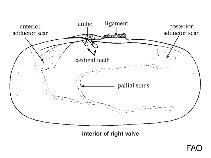Tagelus dombeii (Lamarck, 1818)
Hard razor clam| Native range | All suitable habitat | Point map | Year 2050 |

|
| This map was computer-generated and has not yet been reviewed. |
| Tagelus dombeii AquaMaps Data sources: GBIF OBIS |
تصوير گوگل | No image available for this species;
drawing shows typical species in Solecurtidae.
رده بندی / Names اسامي عام | مترادف | CoL | ITIS | WoRMS
Bivalvia | Cardiida | Solecurtidae
Environment: milieu / climate zone / تغييرات عمق / distribution range بوم شناسي
; تغييرات عمق 0 - 37 m (مرجع 87801). Subtropical; 9°N - 48°S, 83°W - 70°W
Distribution كشورها | مناطق سازمان خوار و بار جهاني (FAO) | Ecosystems | ظهور | معرفي
Eastern Pacific: Panama to Chile.
Length at first maturity / Size / Weight / سن
بلوغ: Lm ? range ? - ? cm Max length : 7.8 cm SHL جنس نر / بدون خواص جنسي; (مرجع 105121)
Life cycle and mating behavior بلوغ | تولید مثل | تخم ریزی | Eggs | Fecundity | Larvae
مآخذ اصلی
مراجع | هماهنگ كننده | همكاران
Aguero, M. 2004 Chile. In Review of the state of world marine capture fisheries management: Pacific Ocean. De Young, C. (ed). 2007. FAO Fisheries Technical Paper 488(1). Rome, FAO. 170 p. (مرجع 82407)
وضعيت در فهرست قرمز IUCN
(مرجع 130435: Version 2025-1)
وضعيت از نظر سايتس (مرجع 108899)
CMS (مرجع 116361)
خطر برای انسان ها
استفاده انسانی
ماهي گيري – شيلات: تجاري
| FishSource |
ابزارها
اطلاعات بيشتر
Max. ages / sizes
Length-weight rel.
Length-length rel.
نوسانات طولی
Mass conversion
فراواني
منابع اينترنتي
BHL | BOLD Systems | CISTI | DiscoverLife | FAO(Publication : search) | Fishipedia | GenBank (ژنوم, نوکلئوتيد) | GloBI | Gomexsi | Google Books | Google Scholar | Google | PubMed | Tree of Life | Wikipedia (برو, جستجو) | Zoological Record



